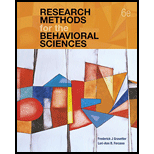
In addition to the key words, you should also be able to define the following terms:
Third-variable problem
Placebo
Directionality problem
Mundane realism
Confounding variable
Experimental realism
Random process
The meaning of the terms related to experimental research
Answer to Problem 1E
Solution:
The definition of all the terms is as follows:
Third variable problem: many a times it is observed that when two variables are studied and a relation of cause and effect is observed in them, there may actually be a third variable, that causes both the variables to change, and thus it appears to us that they are related. Though the actual cause of the change in both the variables is a third variable, this is not considered in the research.
Directionality problem: It is important to know what the cause is and what the effect is, merely getting a relation does not help. When there are two variables it is important to understand, which one is the stimulus and which one of them is the response. Setting the direction of research is important. When there is confusion with regards to the direction it is called directionality problem.
Confounding variable: Any extraneous variable in a research which is not controlled may start varying with the independent variable, and cause to affect the result, that is an extraneous variable if not controlled turns to be a confounding variable. Such a confounding variable that distorts the relation of dependent and independent variable in the research actually is a big threat to the internal validity of the research.
Random process: these are the processes that are time varying functions. Each time unit is assigned an outcome. This process can be used to find average over a period of time. The reason it is called random is because the evolution of the process is random, it is not deterministic.
Placebo: It is the effect observed when a group in the experiment is a given a dose that is not the treatment and causes not effect on the experimental units of this group. The reaction of all these units is observed, since they think that they have received the treatment. This effect is called Placebo effect, and the group that is assigned placebo is called placebo group of control group.
Mundane realism: This implies to the fact that up-to what extent the materials and the processes and the steps used in the research are similar to the real world events. This helps in the generalization of the research outcomes to the real world. It helps in measuring the external validity. It lets us know how close to reality the research is.
Experimental realism: It is the extent to which the situations created in the research are impactful on the participants. It mostly relates to psychology because it tells how participants feel during the experiment, does it match with the real-world experience and if yes, up to what extent does it match.
Explanation of Solution
Conclusion:
Thus by defining various terms related to experimental study, we get better insight of what an experimental study is, what problems are encountered in it, and what is like creating an environment that matches the real world, or a scenario that feels the same.
Want to see more full solutions like this?
Chapter 7 Solutions
Research Methods for the Behavioral Sciences (MindTap Course List)
- Cholesterol Cholesterol in human blood is necessary, but too much can lead to health problems. There are three main types of cholesterol: HDL (high-density lipoproteins), LDL (low-density lipoproteins), and VLDL (very low-density lipoproteins). HDL is considered “good” cholesterol; LDL and VLDL are considered “bad” cholesterol. A standard fasting cholesterol blood test measures total cholesterol, HDL cholesterol, and triglycerides. These numbers are used to estimate LDL and VLDL, which are difficult to measure directly. Your doctor recommends that your combined LDL/VLDL cholesterol level be less than 130 milligrams per deciliter, your HDL cholesterol level be at least 60 milligrams per deciliter, and your total cholesterol level be no more than 200 milligrams per deciliter. (a) Write a system of linear inequalities for the recommended cholesterol levels. Let x represent the HDL cholesterol level, and let y represent the combined LDL VLDL cholesterol level. (b) Graph the system of inequalities from part (a). Label any vertices of the solution region. (c) Is the following set of cholesterol levels within the recommendations? Explain. LDL/VLDL: 120 milligrams per deciliter HDL: 90 milligrams per deciliter Total: 210 milligrams per deciliter (d) Give an example of cholesterol levels in which the LDL/VLDL cholesterol level is too high but the HDL cholesterol level is acceptable. (e) Another recommendation is that the ratio of total cholesterol to HDL cholesterol be less than 4 (that is, less than 4 to 1). Identify a point in the solution region from part (b) that meets this recommendation, and explain why it meets the recommendation.arrow_forwardName the four characteristics of a good definition.arrow_forwardAnd how do I approach it if I dont know what the common variable is?arrow_forward
 Big Ideas Math A Bridge To Success Algebra 1: Stu...AlgebraISBN:9781680331141Author:HOUGHTON MIFFLIN HARCOURTPublisher:Houghton Mifflin Harcourt
Big Ideas Math A Bridge To Success Algebra 1: Stu...AlgebraISBN:9781680331141Author:HOUGHTON MIFFLIN HARCOURTPublisher:Houghton Mifflin Harcourt Algebra for College StudentsAlgebraISBN:9781285195780Author:Jerome E. Kaufmann, Karen L. SchwittersPublisher:Cengage Learning
Algebra for College StudentsAlgebraISBN:9781285195780Author:Jerome E. Kaufmann, Karen L. SchwittersPublisher:Cengage Learning Intermediate AlgebraAlgebraISBN:9781285195728Author:Jerome E. Kaufmann, Karen L. SchwittersPublisher:Cengage Learning
Intermediate AlgebraAlgebraISBN:9781285195728Author:Jerome E. Kaufmann, Karen L. SchwittersPublisher:Cengage Learning Glencoe Algebra 1, Student Edition, 9780079039897...AlgebraISBN:9780079039897Author:CarterPublisher:McGraw Hill
Glencoe Algebra 1, Student Edition, 9780079039897...AlgebraISBN:9780079039897Author:CarterPublisher:McGraw Hill Elementary Geometry For College Students, 7eGeometryISBN:9781337614085Author:Alexander, Daniel C.; Koeberlein, Geralyn M.Publisher:Cengage,
Elementary Geometry For College Students, 7eGeometryISBN:9781337614085Author:Alexander, Daniel C.; Koeberlein, Geralyn M.Publisher:Cengage,





